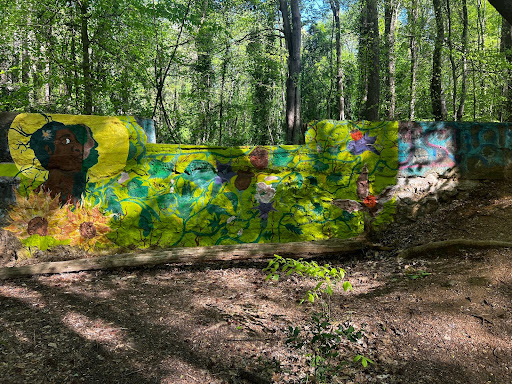There was a distinct sound of birds chirping in the distance, and the smell of dirt and fresh rain lingered on the ground. Beams of light glared from between the tall trees, and the sound of running water was heard nearby. The empty trail in the woods left Guilford College student Jacob Carter feeling fully at peace.
Everything about the forest and the isolated walking trail was exactly what Carter needed to take his mind off the stress of college and upcoming exams. He was in a state of pure bliss, but suddenly, his view of the empty forest changed when he saw signs of human life. Initials and hearts were cut deep into nearby trees, leaving the bark bare and damaged. This sight took Carter right back into reality, and he realized his safe space to connect with nature was tarnished by foolish acts.
To some, tree carvings may seem insignificant or a fun way to enjoy nature. However, not only are the carvings an eyesore to others who may come across them, they’re also damaging to the trees.
One belief that some hold is that it’s OK to carve into trees since, historically, humans have used this as a way to communicate with each other and leave messages behind. However, in today’s digital world, there is no longer a need for that.
It only hurts trees.
While bark seems insignificant, it acts as the skin to a tree, protecting it from all kinds of harm. So, when it’s damaged, it leaves trees vulnerable.
“When a tree is carved into, this protective layer is broken, leaving an open wound, similar to us getting a cut on our skin,” according to a Leave No Trace article published in 2020.
In today’s society, it has become far too normal to disrespect and vandalize the same trees that provide oxygen, sustenance, and material. Carter is not the only person who has observed the negative effects of tree carvings.
“When I go into nature to experience the beauty and peacefulness, I don’t want a reminder of our negative human impact on the natural world,” said Bronwyn Tucker, the visiting instructor for environmental studies at Guilford College.
The major issue with tree carvings is that they’re permanent. Even beautiful tree carvings done by artists still damage the environment in irreparable ways.
Many groups are working to spread awareness about this issue to prevent more trees from being vandalized. Groups such as the Leave No Trace Center for Outdoor Ethics, the Arbor Day Foundation and even the National Park Service are all working to put an end to tree carvings. These organizations have much room for the community to get involved.
While conservation efforts help some, what happens if people continue to damage trees with carvings? Tucker had some opinions when it came to whether or not there should be legal repercussions if people are caught carving into trees.
“While I don’t think legal action is necessary if someone is caught carving a living tree,” said Tucker, “an appropriate response might be a required community service related to tree/forest care. This might include invasive species removal or tree propagation.”
This opinion is becoming more common in environmental activist groups as they put pressure on the National Park Service and U.S. Forest Service to enforce stricter punishments for such actions.
Regardless of whether more regulations are put in place to prevent carving into trees, anyone can help by joining activism groups and spreading awareness to end ignorance. There’s also other ways to help through conservation efforts, such as planting trees or donating to organizations.







